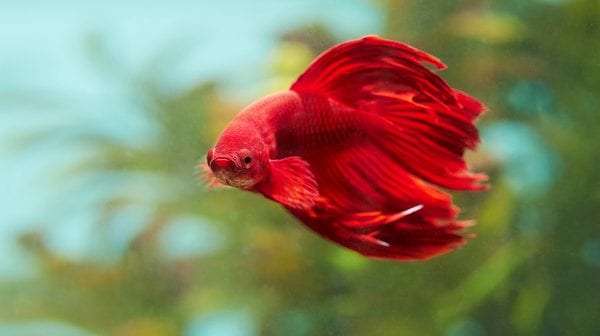Just like humans, fish experience stress too. When fish are stressed, it can have negative effects on their appearance and health. Fish stress can weaken their immune systems, increasing the risk of disease and even death. While fish do experience stress in the wild, it is the most common cause of health issues in aquarium fish. Luckily, through proper fish care, you can reduce most stress factors in your aquarium and prevent having a sick fish.
What Is Fish Stress?
“Stress is a term we use in vet medicine to describe any condition in the environment that causes the release of cortisol and adrenaline in the body,” said Dr. Julius M. Tepper, DVM, Certified Aquatic Veterinarian and fellow at the World Aquatic Veterinary Medical Association in Stafford, England. “These substances are associated with the ‘flight or fright’ reaction and help the animal cope with the stressor.”
When the cause of the stress is continuous, like poor water quality or harassment from other more aggressive fish, the normal immune functions are blocked, which often leads to sick fish with disease conditions like parasites, bacterial infections and fungi, says Dr. Tepper.
What Causes Fish Stress?
Some of the most common causes of fish stress in aquariums include:
- Elevated ammonia and nitrate levels due to infrequent water changes, which is the main cause of stressed goldfish
- pH fluctuation due to the exhaustion of mineral buffers
- Fluctuations in water temperature, which is the main cause of stressed Betta fish
- Lack of hiding places to relieve stress
- Aggressive fish in the same tank
- Overstocking the aquarium, which leads to poor water quality and less oxygen
- Improper introduction of new fish into a community tank
- Inadequate tank size
- Poor nutrition or irregular feeding routine
What Are Stressed Fish Symptoms?
To help reduce fish stress, it’s important to know what to look for. Observe your fish often and watch for any change in your fish’s routine behavior, such as the following:
- Hiding for long periods of time
- “Flitting” or darting around the tank
- Frantic swimming; crashing at the bottom of the tank
- Gasping for air at the surface (a sign of low oxygen levels)
- Scraping against rock or gravel
- Loss of appetite
Stress can also affect your fish’s appearance. Look for changes like:
- A decrease in coloration, especially if your fish is brightly colored
- Red streaking in fins
- White spots on the body, which can be a sign of Ich
- Any visible ailments or sores
If you notice any change in behavior or appearance that may be indicative of a sick fish, consult your veterinarian.
Ways to Reduce Fish Stress
The best way to prevent or reduce fish stress is to provide them with a healthy environment. That includes stocking the tank with the right amount of aquarium decorations and having the proper aquarium supplies. You want to ensure that they are receiving the proper fish care that minimizes triggers.
- Change water frequently to keep nitrate and ammonia levels low. Try adding water conditioners like API Stress Coat Aquarium Water Conditioner, which is formulated to reduce fish stress by 40% by removing dangerous toxins. Or try API Stress Zyme Aquarium Water Conditioner, which keeps your aquarium cleaner and helps boost its natural cycle.
- Check water temperature for consistency regularly to prevent stressful fluctuations.
- Provide an optimal filtration system like the Fluval Underwater Filter that captures debris and bacteria while ensuring proper oxygenation.
- Provide hiding places, like the Marina Mangrove Root Aquarium Decor, but be careful not to overcrowd your tank, which can interfere with proper oxygen flow.
- Before you add fish to your community, ensure they are compatible with your current fish to prevent stress from harassment or fighting.
- Introduce new fish properly, preferably by immersing them in the tank while still in their plastic bag, to help them adjust to the water temperature, and for your current fish to get used to their new tank mate.
- If you notice harassing behavior, remove the aggressive fish and place in a separate tank.
- Give your fish adequate space; the general rule is a fish of 1 inch length needs 1 gallon of water.
- Feed them proper amounts of food regularly, and if possible, at the same time of day.
By providing a healthy, stable aquarium environment and observing your fish for any signs of behavioral or physical change, you can reduce the risks of fish stress and keep a healthy, serene tank.
Chris Brownlow has been writing about pets for over 10 years. As a writer who believes in immersing herself in her topic, she has tasted more than 20 different flavors of dog and cat food while working on an advertising campaign for PetSmart. Prior to her pet days, Chris was a print and digital journalist at The Tampa Tribune and The Virginian-Pilot.
How to Calm Down Stressed Fish
It can be difficult to notice when our pets are in distress, especially because they can’t tell us exactly what’s wrong. For aquatic life, this can be even more challenging, as can knowing what to do once a problem has been recognized. The truth is, even small, subtle changes in fish behavior or appearance can indicate stress. It’s important to know how fish become stressed and how to react quickly when it happens.
Why fish get stressed
Anyone who has fish knows that they are complicated creatures. Like humans, they get stressed but in ways you might not have considered. Some of the most common fish stressors include:
Poor water quality or incorrect water temperature: Besides the actual water that you put into your aquarium, water quality is impacted by a number of other factors, including the filter system (and whether it’s working properly), the accessories and décor in the habitat (gravel, aquatic plants and other objects), the food you feed your fish and even your fish itself. Different species of fish also require different water temperatures throughout the day. Without clean, properly maintained water, fish can easily become stressed.
Moving to a new aquarium: Fish are extremely susceptible to stress due to changes in their environment. This is why cleanings—and especially making the move to an entirely new aquarium—should be done carefully and properly. Speak with a Petco aquatics specialist before you move your fish to a new aquarium to ensure you’re following the best procedure to avoid as much stress as possible for your fish.
Overcrowding: Not all fish are compatible and, even when they are, each one requires a certain amount of space in order to happily live and grow. Adding fish to an aquarium also increases the waste output, which may necessitate updates to filtration and additional cleaning procedures.
Lack of aquarium décor: While overcrowding an aquarium isn’t a good idea, neither is leaving it completely empty. The type of substrate you use is important (gravel and stone, for example, help provide a surface for good bacteria to colonize, which helps keep nitrogen levels in check), while real plants help stabilize nitrogen and CO2 levels. Adding décor for your fish to hide in and swim around is not only fun for them but often helps reduce stress in the aquarium, as long as you remember to clean it regularly.
Improper diet: Your fish require a species-specific diet. The proper diet will help your fish live a long and healthy life, while an incorrect one may leave your pet lacking needed nutrients. Food remnants can also affect water quality and cause an aquarium to become dirty when excess food is not removed after feeding and buildup occurs between cleanings; making an effort not to overfeed your tank can help prevent these problems.
Illness or injury: A fish who is suffering in some other way—like from an illness or injury—will likely have some additional stress side effects as well.
How to calm down stressed fish
If you notice that your fish is breathing heavily or gasping for air, or if you pick up on any behavioral (reduced activity, excessive hiding, sporadic movements or decreased appetite), physical (nicks or tears) or color changes (lighter to darker, darker to lighter, discoloration or spots), they could be suffering from stress.
Before you can determine how to best help them, you’ll need to try to troubleshoot the cause. Run through the items above to determine if any of those factors have recently changed.
Depending on the changes that may have recently taken place, you can try:
- Using a water quality test kit to ensure your habitat is at optimal pH, nitrate and ammonia levels for your fish’s species. You can also bring a sample of water into your local Petco where someone can test it for you.
- Checking that the filtration system is operating properly.
- Examining your fish’s skin and fins for fading colors (which could indicate skin or gill flukes) or small white specks (which could indicate Ich).
- Trying a stress coat product, which can help remove chlorine, neutralize chloramines and detoxify heavy metals to set up optimal water conditions. It can also help heal skin wounds and torn fins.
- Reducing overcrowding by moving additional fish to a new tank, or getting a larger aquarium.
- Provide additional oxygen to your tank by ensuring there is enough surface area of the water exposure to air, by using a waterfall, air pump or adding live plants.
If you think your fish may be stressed, speak to an aquatics specialist who may be able to help diagnose the issue and help you find a solution.
How to Calm Down Stressed Fish



